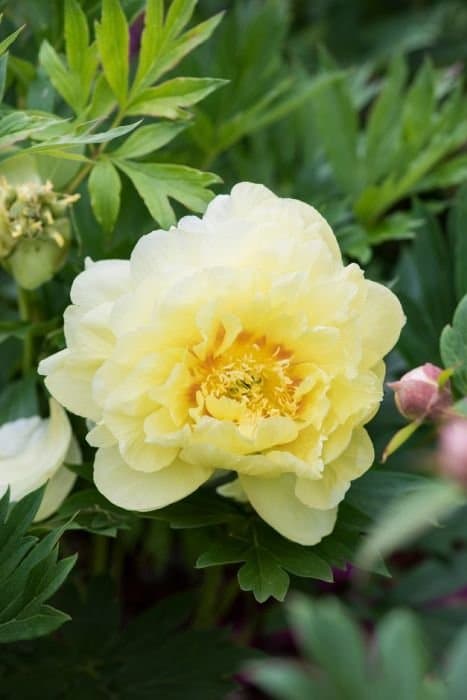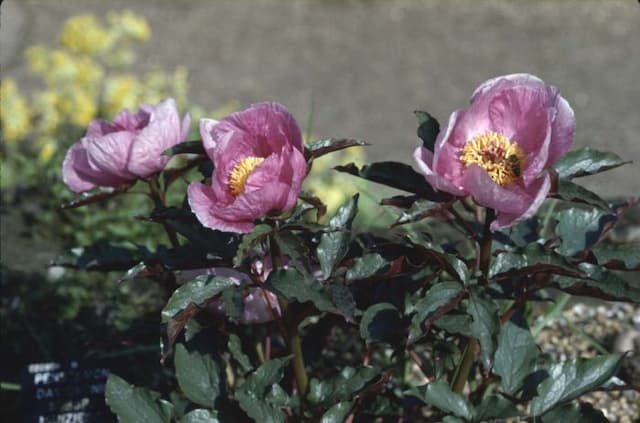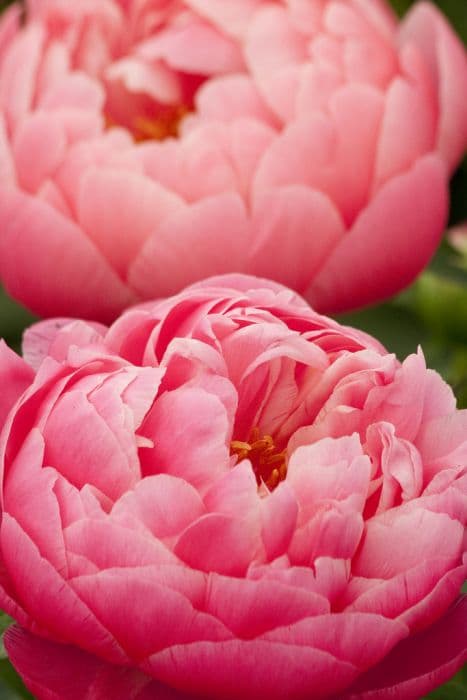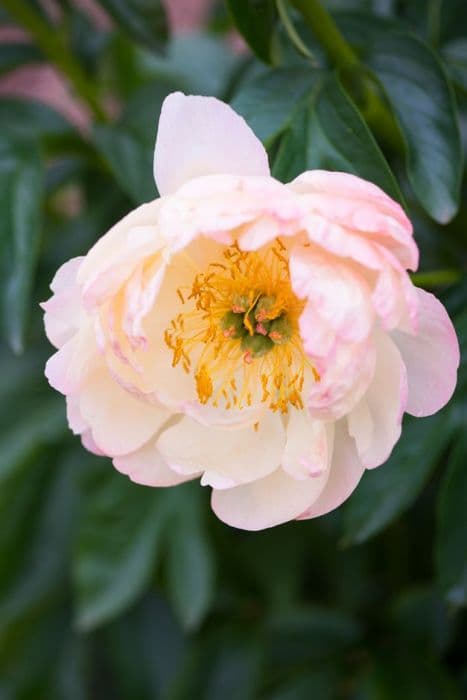Peony Paeonia 'Golden Isles'

ABOUT
The Paeonia 'Golden Isles' is a variety of Peony distinguished by its vibrant blooms and lush foliage. This plant typically features large, bowl-shaped flowers that exude a warm, appealing glow. The flower petals have a saturated yellow hue with a gradient that may range from a soft buttery tone to a deeper golden color, giving this variety its name. At the center of the flowers, there's often a dramatic contrast with a tuft of smaller, frilly petals that may take on a lighter color, often adorned with a reddish or pinkish tinge at the base. Surrounding the showy flowers, the Peony 'Golden Isles' has a wealth of dark green leaves that provide a rich background to the luminous blooms. These leaves are typically broad and deeply lobed, contributing to the plant's robust and hearty appearance. The overall visual impression of the plant is one of opulence and brightness, making it a standout specimen in any garden setting where color and vibrancy are desired. The foliage and the blooms together create a luxurious display that can capture the attention and admiration of onlookers, particularly when in full bloom.
About this plant
 Names
NamesFamily
Paeoniaceae
Synonyms
Peony, Garden Peony
Common names
Paeonia 'Golden Isles'.
 Toxicity
ToxicityTo humans
Peony 'Golden Isles' is generally considered non-toxic to humans. It does not typically pose serious harm if small amounts are ingested. However, as with many plants, consuming peony in larger quantities might cause stomach upset or an allergic reaction in sensitive individuals.
To pets
Peony 'Golden Isles' can be toxic to pets if ingested. If a pet eats part of a peony, they may experience mild to moderate gastrointestinal upset, with symptoms such as vomiting or diarrhea. It's advised to monitor your pet closely and consult a veterinarian if they consume any part of the plant.
 Characteristics
CharacteristicsLife cycle
Perennials
Foliage type
Deciduous
Color of leaves
Green
Flower color
Yellow
Height
2-3 feet (60-90 cm)
Spread
2-3 feet (60-90 cm)
Plant type
Herbaceous
Hardiness zones
3-8
Native area
Asia
Benefits
 General Benefits
General Benefits- Aesthetic Appeal: Paeonia 'Golden Isles', commonly known as Peony, has showy blooms that enhance the beauty of gardens and landscapes.
- Variety of Colors: Peonies come in various colors, allowing for diverse design and color schemes in garden settings.
- Perennial Growth: Peonies are perennials, meaning they come back each year, reducing the need to replant annually.
- Attracts Pollinators: Their large flowers attract bees and other pollinators, supporting local ecosystems.
- Low Maintenance: Peonies generally require minimal care once established, making them ideal for gardeners of all skill levels.
- Cold Hardiness: They are capable of withstanding cold winters, which makes them suitable for growing in a variety of climates.
- Long Blooming Season: Peonies have a relatively long flowering period, which extends the visual enjoyment of their blooms.
- Cut Flower Use: Peony flowers are popular for cutting and using in floral arrangements due to their size and beauty.
- Drought Tolerance: Once established, peonies can tolerate dry conditions, although they prefer consistent moisture.
- Deer Resistance: Peonies are generally not preferred by deer, making them a great choice for areas with deer populations.
 Medical Properties
Medical PropertiesThis plant is not used for medical purposes
 Air-purifying Qualities
Air-purifying QualitiesThis plant is not specifically known for air purifying qualities.
 Other Uses
Other Uses- Cut Flowers: The Paeonia 'Golden Isles', commonly known as Peony, is highly valued as a cut flower for its attractive blooms that can add elegance to any bouquet or flower arrangement.
- Art and Photography Subjects: The vibrant flowers of the Peony are often used as subjects in art and photography due to their beauty, providing inspiration to artists and photographers.
- Culinary Decoration: Although not consumed, Peony petals can be used as a decorative element for plating in high-end culinary dishes, adding visual appeal with their color.
- Perfumery: The Peony's fragrant blooms can be used in the production of natural perfumes or to provide a model scent for synthetic fragrances.
- Drying for Crafts: Dried Peony petals and leaves can be used in crafting, such as in making potpourri, scrapbooking, or creating floral displays.
- Wedding Decor: Peonies are often used in wedding ceremonies, not only in bridal bouquets but also as part of the venue's floral decor, centerpieces, and arch decorations.
- Color Inspiration: The colors of Peony flowers can serve as inspiration for interior design, fashion, and palettes in various creative industries.
- Educational Use: Peonies can be used in educational settings, such as botanical studies and horticulture classes, to teach about plant biology and propagation techniques.
- Garden Design: Although not unusual, Peonies are a staple in garden design for their capacity to provide strong visual impact and structure in landscape compositions.
- Ritual and Symbolism: In certain cultures, Peonies are used in rituals and are symbolic of wealth, good fortune, or as a talisman to ward off negative energies.
Interesting Facts
 Feng Shui
Feng ShuiThe peony is not used in Feng Shui practice.
 Zodiac Sign Compitability
Zodiac Sign CompitabilityThe peony is not used in astrology practice.
 Plant Symbolism
Plant Symbolism- Prosperity: Peonies often symbolize wealth and honor, which makes them symbols of prosperity due to their lush, full blossoms and rich colors.
- Romance: Peonies are frequently associated with romance and romantic love, often used in wedding bouquets and decorations to symbolize a happy marriage.
- Good Fortune: In some cultures, peonies are considered to bring good luck and fortune, making them a popular gift for new beginnings and celebrations.
- Beauty: The peony, with its attractive and large blooms, is commonly regarded as a symbol of beauty in various forms, both physical and spiritual.
- Compassion: Peonies may represent compassion due to their soft, plush petals and nurturing appearance that evoke a sense of care and consideration.
 Water
WaterPeonies, including the Paeonia 'Golden Isles', should be watered deeply about once a week, providing approximately one inch of water each time. During the growing season, especially if the weather is very dry, increasing watering to twice a week may be necessary. The key is to keep the soil moist but not waterlogged. It's best to water early in the morning to allow foliage to dry before nightfall. Overhead watering should be avoided to reduce the risk of fungal diseases; instead, water at the base of the plant. During the winter, peonies require less water as the plant is dormant.
 Light
LightPeonies like the Paeonia 'Golden Isles' thrive best in full sun to partial shade conditions. They require at least six hours of direct sunlight per day for optimal growth and flower production. An ideal spot would be an area that enjoys morning sunlight and some shade during the hottest part of the afternoon, although full sun all day is also well-tolerated by peonies.
 Temperature
TemperaturePeonies, such as the Paeonia 'Golden Isles', are cold-hardy plants that prefer temperate climates. They can withstand winter temperatures as low as -20°F and require a period of chilling for successful bud formation. The ideal growing temperatures for peonies range from 65°F to 75°F during their growing season. They perform poorly in areas where temperatures do not drop below 40°F in winter or exceed 85°F during their growth period.
 Pruning
PruningPeonies including the Paeonia 'Golden Isles' require pruning to help prevent disease and to remove spent blooms, which encourages healthy growth for the next season. Pruning should be done in the fall after the leaves have died back, typically after the first frost. Remove all the dead foliage and cut the stems down to about 3 inches above ground level. Pruning in the fall helps remove any diseased or pest-infested plant material and prepares the plant for winter.
 Cleaning
CleaningAs needed
 Soil
SoilPeonies, including 'Golden Isles', prefer a well-drained loamy soil with a neutral to slightly alkaline pH between 6.5 and 7.5. For optimal growth, a soil mix composed of two parts loam, one part peat moss or well-rotted compost, and one part coarse sand or perlite is ideal. Good drainage is crucial to prevent root rot, and adding organic matter can help improve soil structure and fertility.
 Repotting
RepottingPeonies, such as 'Golden Isles', are perennial plants and typically do not require frequent repotting once established in the garden. Repotting or dividing should be done in the fall every 5 to 10 years if they become overcrowded, but peonies are generally long-lived and can thrive in the same location for many years without being disturbed.
 Humidity & Misting
Humidity & MistingPeonies like 'Golden Isles' tolerate a wide range of humidity levels but prefer average atmospheric humidity. They do not have specific humidity requirements, and as garden plants, they are accustomed to the fluctuations of outdoor conditions. Therefore, typical outdoor humidity should be suitable for their growth.
 Suitable locations
Suitable locationsIndoor
Grow peonies inside by ensuring ample sunlight and cool temperatures.
Outdoor
Plant in sun-rich, well-drained soil; ensure winter chill for dormancy.
Hardiness zone
3-8 USDA
 Life cycle
Life cycleThe life of a peony 'Golden Isles' begins with seed germination, where the dormant seed activates and sprouts when exposed to the appropriate environmental conditions, typically requiring a period of cold stratification to break dormancy. Once sprouted, the seedling grows into a juvenile plant, developing a strong root system and foliage through photosynthesis. As the plant matures, it enters the vegetative stage, producing larger leaves and stems in preparation for flowering. When mature enough, the peony enters the flowering stage, typically in late spring to early summer, displaying large, vibrant blooms that are attractive to pollinators. After pollination and flower senescence, the plant produces seeds, completing the reproductive cycle. During the fall, the peony 'Golden Isles' enters dormancy, with foliage dying back and the plant conserving energy in its roots for the next growing season.
 Propogation
PropogationPropogation time
Spring-Early Summer
The Paeonia 'Golden Isles', commonly known as the peony, is typically propagated by division, which is best performed in the fall after the plants have gone dormant. The most popular method for propagating peonies is through root division, because peony seeds can take a long time to germinate and are not as reliably true to the parent plant. To propagate by division, carefully dig up the peony plant, taking care not to damage the roots. Wash the soil off the roots, and using a sharp knife or garden shears, cut the root mass into sections, making sure each section has 3-5 eyes, which are the small red buds from which new shoots will grow. Replant the divisions immediately, setting them so the eyes are no deeper than 2 inches (about 5 centimeters) below the surface of the soil. This allows for optimum growth and avoids planting too deep, which can prevent the plant from blooming. Water the newly planted divisions thoroughly to help them establish.









